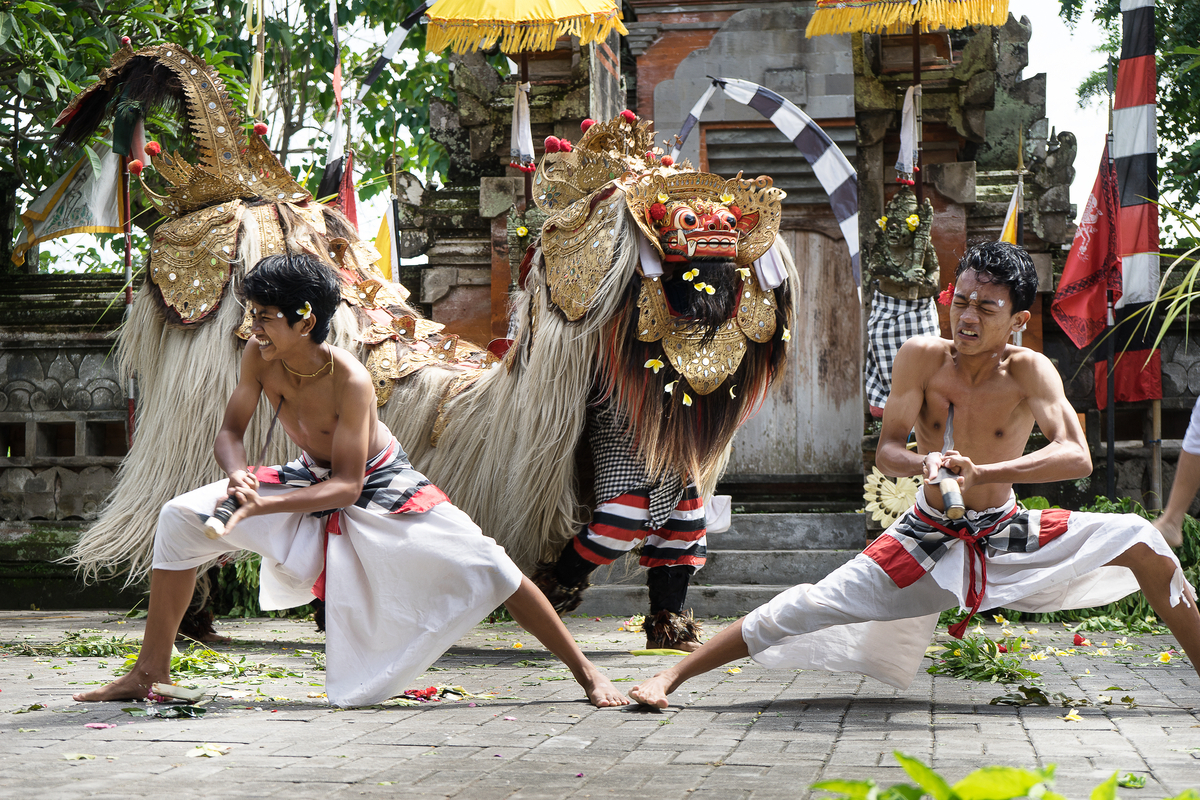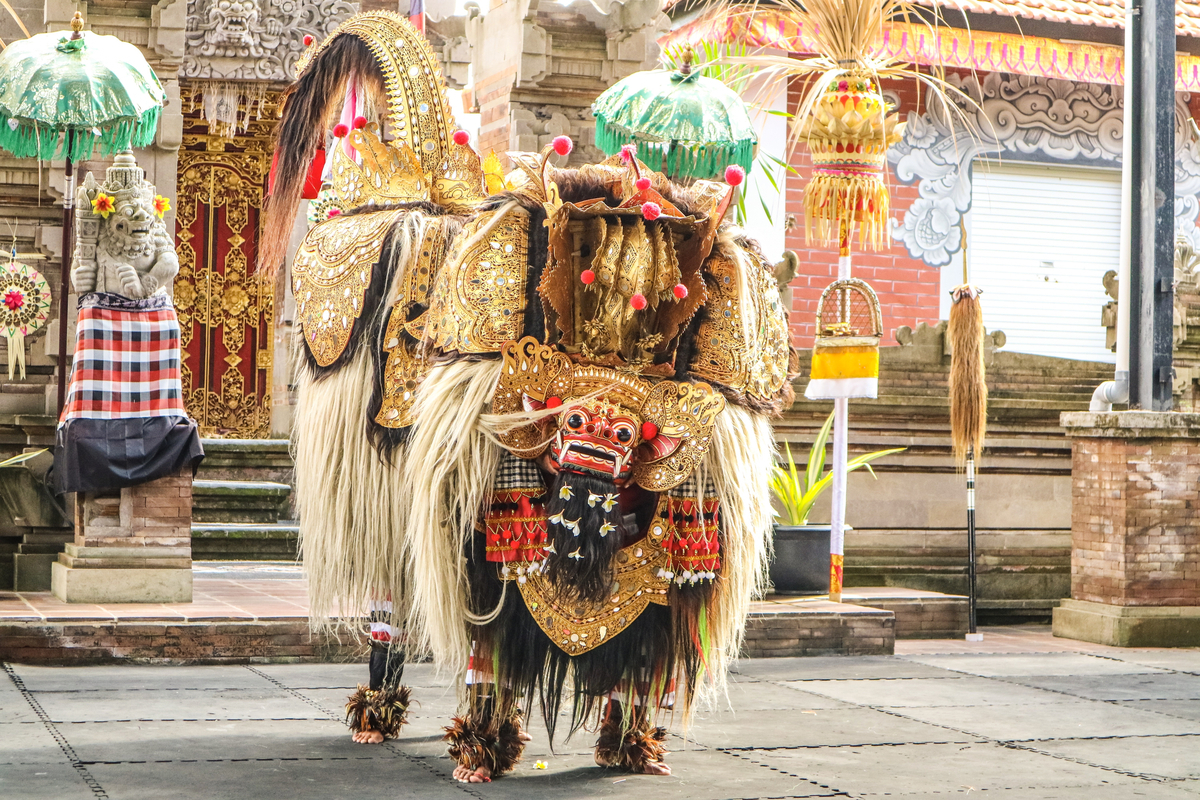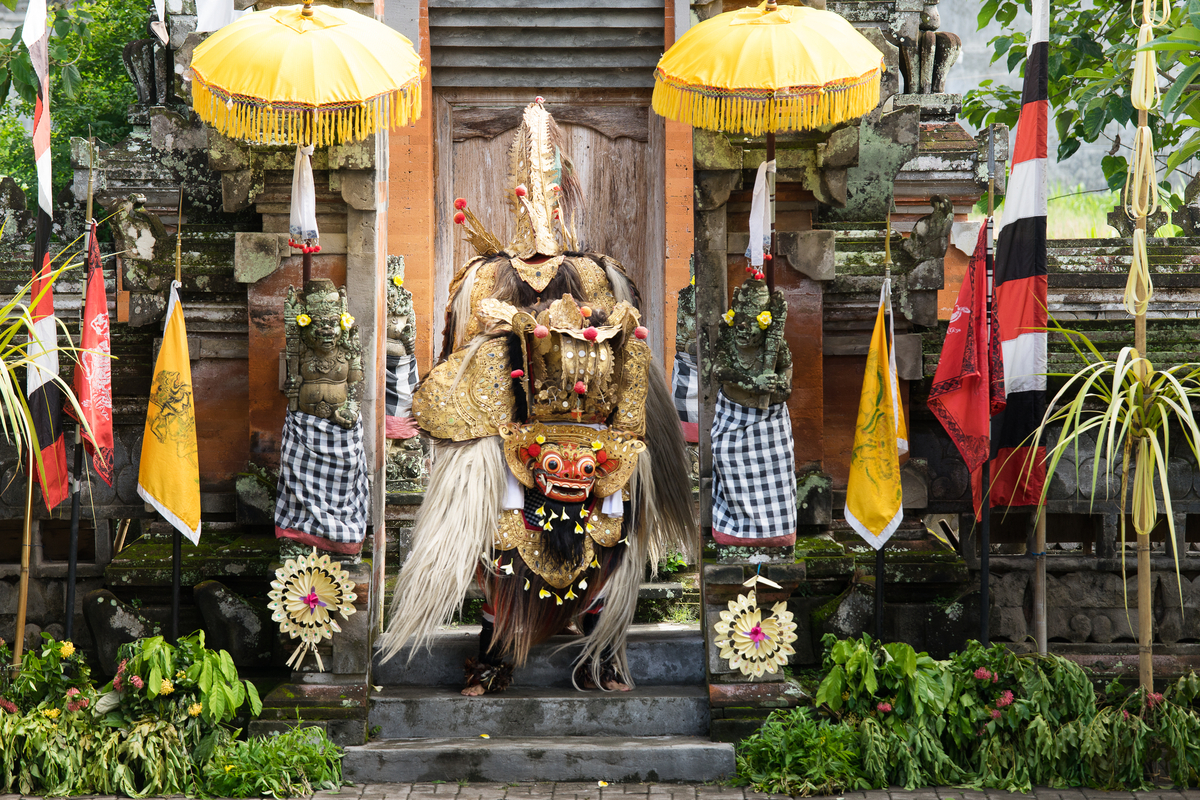BALI HAS UNIQUE CULTURE THAN OTHER IN THE WORLD
1.The Barong and the Kris Dance: The Eternal Battle Between Good and Evil
We wondrous island of Bali is not only blessed with fascinating beaches and outstanding landscapes, but it also has an amazing traditional culture that remains well preserved, highlighting the daily life of its peopl360
The Barong Dance is among the many art forms closely associated with spirituality, it is often performed in ritual ceremonies. Portraying the classic battle of “Good vs. Evil”, the dance is one of the most well-known and loved on the island.

In Balinese mythology, Barong is a prominent character taken the form of a lion, regarded as the King of the Spirits who represents Virtue. Barong is seen as ‘a guardian angel’. Opposing Good is represented by another mythical creature called Rangda (‘widow’ in Javanese), the Queen of Demons. Rangda leads an army of evil witches against the leader of the forces of Good. As a mirror of life, the Barong Dance portrays the two characters involved in a never-ending battle.
Similar to Sanghyang Dance, the Barong Dance is native to the Balinese culture that predates back to Hinduism. Barong is covered in white thick fur, adorned with gold jewelry and pieces of mirrors. Just like the Chinese Lion Dance, Barong involves two people dancing in synchronized movements to portray the lion in action.

In the dance drama called Calon Arang, Barong emerges to counteract Rangda's use of magic to control the world. The men will fight each other with kris daggers, but upon the appearance of Barong, they turn their kris and stab themselves. The performers get into a trance state. Barong then defeats Rangda, thus restoring balance in nature. Meanwhile, the tranced men are reincarnated by the sprinkle of holy water.
Balinese people believe each region has its own protective spirit for its forests and lands. For each region, Barong is modeled after a different animal. Barong Ket (Lion Barong) is the most common type found in almost every part of the Island. While Barong Buntut is a type of Barong which only features its front, usually performed by a single dancer. Other types of Barong includes Barong Landung (Giant Barong), Barong Celeng (Boar Barong), Barong Macan (Tiger Barong), Barong Naga (Dragon/Serpent Barong).

2.The History of Bali Kecak Dance
Bali Kecak dance has been famous around the world. The people around the world visit Bali to see its beauty and culture. The foreigners are really amazed with this dance in which give them such a spiritual experience when watching it. The dance is not like other Balinese dances. This dance is performed by many people with a story in it.
The history of Bali Kecak dance
Bali Kecak dance is created by a Balinese dancer named I Wayan Limbak with collaboration with Walter Spies, a painter from Germany. They started to create this dance in 1930. These people had found their interested in a spiritual Balinese dance. At the first time they saw Sanghyang dance, a dance which can make the dancer become possed by holy spirit so that the dancer is in trance condition. The dancer does not remember anything at this time. The dancer has been possed by a holy spirit which is included into sacred dance. There are two kinds of Sanghyang dance, first is Sanghyang Dedari dance and the second is Sanghyang Jaran dance. Sanghyang Dedari dance is performed by two girls who are still pure and Sanghyang Jaran is perfomed by two boys who ride a imitated-horse. The dance is a ritual dance where fire is becoming the main point of this dance.
How Kecak dance is performed
I Wayan Limbak and Walter Spies had implemented this sacred dance into this Bali Kecak dance. The story of this dance is proposed from Ramayana epic, especially the scene when Rama fought Ravana, the giant who kidnnaped Sita, Rama’s wife. The Ramayana dancers are surrounded by approximately fifty until one hundred and fifty men. The surrounded men will shout ‘cak´ as chant which means that they are in trance along with shouting the chant. While they are shouting ‘cak´ chant, they raise their hands and close their eyes. At this moment, the dancers are also in trance condition. They are possed by Rama’s soldiers, the Holy Monkeys.
3.Seven Most Important in Bali
Bali is renowned for its bright and richly cultural ceremonies, and any visitor who spends more than a few days on the island will be certain to stumble upon a temple festival, colourful procession, or simply a village doing their ritual. Stay longer and you’ll bound to be invited to with family rituals such as birth celebrations, tooth filing ceremonies, weddings and cremations.
Aside from the above, there are also numerous island-wide religious festivals to mark sacred days according to the Balinese calendar that you can witness, or be part of.
Nyepi Day silence day of Balinesse new year
The day of silence across Bali The month of March brings Nyepi – the day of silence throughout the whole of Bali. In the Balinese lunar calendar (Saka), Nyepi is New Year’s Day. It is a day wholly dedicated to rest, staying in, turning off the lights and keeping quiet for 24 hours. It is one of the biggest and most unique ceremonies of the year, where staying in and resting is enforced by law. It is practiced island-wide where the Balinese dedicate an entire day to introspection and spiritual cleansing. No businesses are open, no transport is allowed on the roads (except for emergency services) the airport even shuts down for 24 hours. Nyepi is a sacred day to give the island a break from 364 days of human activity, so Bali can replenish and recharge for the new year. Nyepi is a 6-day long festival, the ‘silent’ day falls on day 3 and is the most important and sacred Hindu holiday in Bali. It is also a public holiday for the rest of Indonesia.
Galungan and Kuningan day
Galungan is a Balinese holiday which celebrates the victory of dharma over adharma (the triumph of good over evil). It marks the time when ancestral spirits of deceased relatives visit the Earth. The last day of the celebration is Kuningan, when they leave earth. The spirits of deceased relatives return to visit their former homes and the Balinese have a responsibility to be hospitable and welcoming to their past ancestors through prayers and offerings throughout their home. The most obvious sign of the celebrations are the penjor – bamboo poles with offerings suspended at the end which line the roads.
Pagarwesi day
Pagerwesi is the day when the Balinese strengthen their minds and souls against evil forces. Pagerwesi is also called “rerainan gumi” by the Balinese and means the holiday for everyone from every background – from the families of priests to the common families.
The Balinese celebrate the Pagerwesi ceremony every six months according to the Balinese pawukon calendar, the celebration is usually three days after Saraswati. Pagerwesi derives from the two Balinese words pager and wesi, which means fence and iron. The iron fence is a symbol of strong self-protection and on pagerwesi the Balinese focus on building a strong personal fortification to ensure that evil doesn’t enter their minds, speech and deeds, to avoid harm to their surroundings.
Tumpek Landep day
Nowadays Tumpek Landep is a ceremonial day at which offerings are made for objects that are made of metal. The ceremonies start in the morning hours at the village temple when people gather for special prayers and blessings. Afterwards, at the home compounds, additional ceremonies and blessings follow at which offerings are made for the holy family keris that most families own, but also for cars and motorbikes. In these modern times, also other objects that contain metal, such as computers, may be subject to these ceremonies. Most Balinese people truly believe that these ceremonies and blessings will bring them luck and keep them safe in traffic. Tragically, at the day of Tumpek Landep the hospitals in Bali show a peak in the treatments of especially motorbike accidents.
Odalan day
In Bali there are over 4,500 temples where ceremonies take place almost every day of the year and Odalan is the celebration of each temple’s anniversary. Temple festivals are held on the anniversary of when the temple was consecrated and usually on a new or full moon.
An Odalan or temple ceremony usually lasts for three days, but larger ones, which occur every 5, 10, 30 or 100 years, can last for 11 days or longer. The gist of what is happening here is that the Balinese are honoring the deities that rule over the temple by giving them a myriad of offerings, performances of vocal music, dance and gamelan music.
Tumpek Kandang day
Tumpek Kandang is the day to worship Sang Hyang Rare-Angon, the God of animals. The name of Tumpek Kandang is derived from two words, “Tumpek” meaning Saturday and “Kandang”, the Balinese word for the household animals such as cows, pigs, chickens, ducks, dogs, and birds – all of which are highly valued by the Balinese. On this day, pigs are usually decorated with a white cloth wrapping their bellies. The animals are then fed with special foods, sprinkled with rice and holy water and prayers are offered.
This ritual certainly is not an animal worship ritual, The Balinese consider animals as friends for life created by God as a living creature.
Full Moon
Full Moon is believed to be the day when God answers prayers and it is considered to be a favorable day to plant things in the garden, especially fruit plants. Purnama helps to obtain an abundant harvest the following year.
The Balinese prayers includes honouring the shadow and light to find balance in life. This play of opposing forces and the acceptance of light and dark, joy and sorrow, benevolence as well as maliciousness is called Rwa Binneda in Balinese culture.
4.BALINESE HINDU NGABEN CEREMONY
BALINESE HINDU NGABEN CEREMONY IS BALINESE CREMATION RITUAL TO SEND THE DECEASED TO THE NEXT LIFE
Balinese Ngaben Ceremony or Cremation Ceremony, is the ritual performed in Bali to send the deceased to the next life. The body of the deceased will be placed as if sleeping, and the family will continue to treat the deceased as sleeping. No tears are shed, because the deceased is only temporarily not present and will reincarnate or find his final rest in Moksha (freeing from the reincarnation and death cycle).
The proper day of the Ngaben ceremony is always a matter of consulting a specialist on ceremony days. On the day of the ceremony, the body of the deceased is placed inside a coffin. This coffin is placed inside a sarcophagus resembling a buffalo (Lembu) or in a temple structure (Wadah) made of paper and wood. The buffalo or temple structure will be carried to the cremation site in a procession. The procession of Ngaben is not walking in a straight line. This is to confuse bad spirits and keep them away from the deceased.
Ngaben is on of the most important ceremony in Bali. Because human body consist of 10 basic elements. One 5 elements we call as Panca Maha Butha or five macro cosmos element: Pertiwi (soil), Apah (water), Teja (fire), Bayu (air) and Akasa (ether or space). And the other 5 memories elements we call as Panca Tan Matra which is the five element that influence us from our sense which is consist of: Ganda (from the nose or smell), Rasa (from the tongue), Rupa (from the eyes), Sparsa (from the skin sense), Sabda (from the ears).
After all been burning and cremating there is still another step because the atman or spirit are still have other part of element that need to be eliminated that we call Panca Karmendria or five major sin that we are doing. The Panca Karmendria is consist of: Padendria (sin that coming from our path of life), Payundria (sin that coming from our food in life), Panendria (sin from our hand created), Upastenindia (sin from our sexual behavior), and Wakindriya (sin from our speech or our mouth). The ceremony to “erase” those sin is we call as “Nyekah” It doesn’t mean that we will be free from those sin after the Nyekah ceremony, but it is actually the recap of our sin. And the result will becoming the report that “atman” or spirit has that will result whether he or she to be reincarnated or not. This report it self we call it as Karma Wasana. So “Ngaben” is basically helping the atman to reach his/ her status as quick as possible to “Brahman” or God to the next level and there are several layer of “wrapper” that need to be remove by doing Ngaben and Nyekah ceremony..
And for the people who still alive, Ngaben and Nyekah are the good filosophy the remind us to always create good karma in life. So our report or Karma Wasana can lead us to Moksatham Jagadhita Ya Ca Ithi Dharma or free from reincarnation. This also showing us that Hinduism is not about getting heaven but how to be one with Brahman or God, free from circle of life.












No comments:
Post a Comment